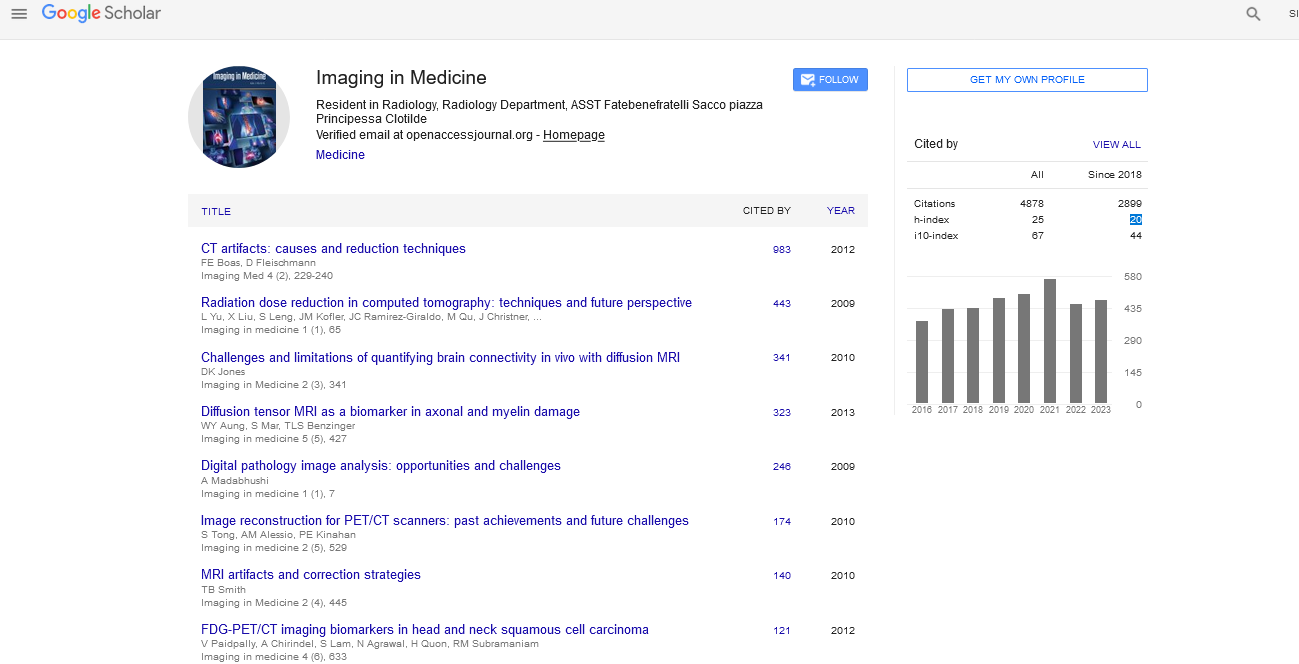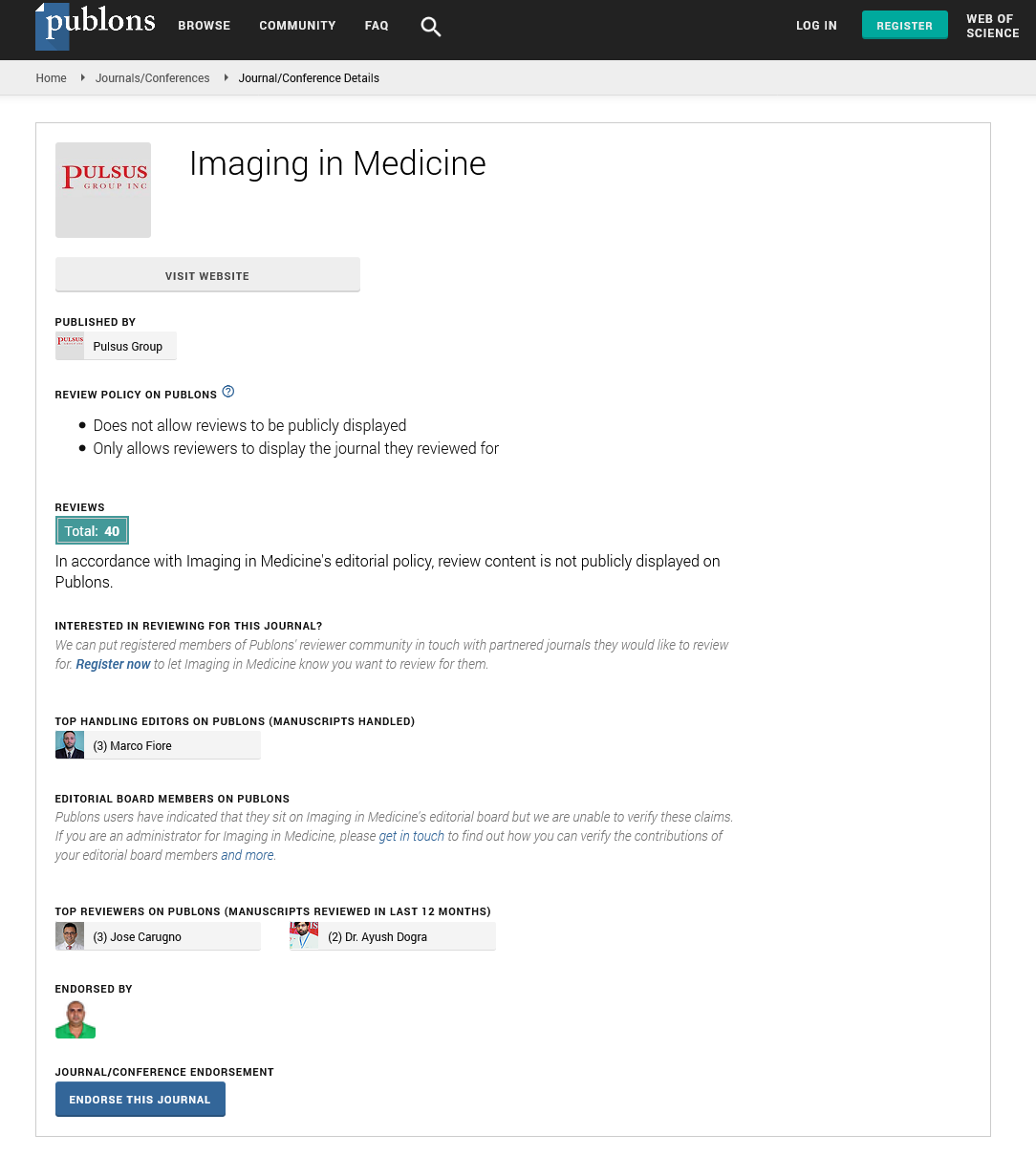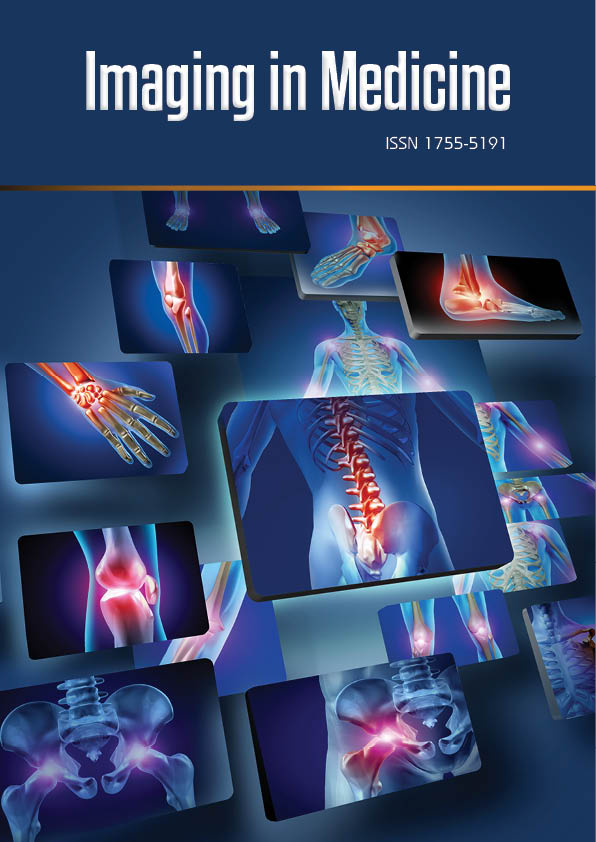Editorial - Imaging in Medicine (2025) Volume 17, Issue 1
Radiology: Unlocking the Human Body Through Medical Imaging
Shweta Ravi*
Department of Radiology, University Hospitals Cleveland Medical Center, Cleveland, Ohio, United States
- *Corresponding Author:
- Shweta Ravi
Department of Radiology, University Hospitals Cleveland Medical Center, Cleveland, Ohio, United States
E-mail: shweta@gmail.com
Received: 17-Jan-2024, Manuscript No. fmim- 25-169970; Editor assigned: 20-Jan-2024, PreQC No. fmim-25-169970 (PQ); Reviewed: 04-October-2024, QC No. fmim-25-169970; Revised: 14-Jan-2024, Manuscript No. fmim- 25-169970 (R); Published: 21-Jan-2024, DOI: 10.47532/1755-5191.2025.17(1).1-3
Introduction
Radiology is the cornerstone of modern medicine, offering a window into the human body without the need for invasive surgery. It involves the use of various imaging techniques—such as X-rays, CT scans, MRI, and ultrasound—to diagnose, monitor, and sometimes treat diseases. By providing detailed visual insights [1], radiology enables doctors to detect abnormalities early, guide surgical procedures, and track the progress of treatments. Over the past century, advances in radiology have transformed healthcare into a more precise, effective, and patient-centered field.
The Evolution of Radiology
The discipline of radiology began with Wilhelm Conrad Roentgen’s discovery of X-rays in 1895. Initially used for simple imaging of bones, the field quickly expanded to include soft tissues, organs, and blood vessels. Today, radiology encompasses not only diagnostic imaging but also interventional procedures, where imaging techniques help guide minimally invasive treatments. The growth of computer technology and artificial intelligence (AI) has further enhanced radiology by improving image clarity, reducing scan times, and assisting in early disease detection.
Key Imaging Techniques
Radiology comprises a wide range of imaging methods, each suited for specific medical needs:
X-rays: The oldest and most widely used imaging technique, ideal for detecting bone fractures, infections, and lung diseases [2].
Computed Tomography (CT): Produces cross-sectional images of the body, useful in trauma cases, cancer detection, and vascular studies.
Magnetic Resonance Imaging (MRI): Uses powerful magnets and radio waves to generate highly detailed images, especially valuable in neurology, orthopedics, and cardiology.
Ultrasound: Employs sound waves for real-time imaging, commonly used in obstetrics, cardiology, and abdominal diagnostics.
Nuclear Medicine: Involves the use of small amounts of radioactive material to evaluate organ function, such as thyroid, heart, and kidney performance.
The Role of Interventional Radiology
Beyond diagnostics, radiology has evolved into a therapeutic field through interventional radiology (IR). In IR, radiologists use imaging guidance to perform minimally invasive procedures such as angioplasty, tumor ablation, or targeted drug delivery [3]. These procedures often reduce the need for open surgeries, minimize recovery times, and lower risks for patients.
Radiologists: The Specialists Behind the Screens
Radiologists are highly trained medical doctors who interpret imaging studies and provide essential information for patient care. They collaborate with other healthcare providers to determine accurate diagnoses and treatment plans. Subspecialties within radiology include neuroradiology [4], pediatric radiology, musculoskeletal imaging, and breast imaging. Their expertise extends to emergency medicine, oncology, cardiology, and virtually every area of healthcare.
Challenges and Future Directions
Despite its immense benefits, radiology faces several challenges. The high cost of imaging equipment, exposure to radiation in some modalities, and shortages of trained specialists remain pressing concerns. Additionally, the growing volume of imaging studies places heavy demands on radiologists. However, innovations such as AI-driven image analysis [5], portable imaging devices, and low-radiation technologies promise to address these issues. The future of radiology lies in greater precision, efficiency, and accessibility—making advanced imaging available to broader populations worldwide.
Conclusion
Radiology has revolutionized medicine by enabling physicians to see inside the human body with remarkable clarity. From its origins with X-rays to today’s cutting-edge MRI and interventional techniques, radiology continues to play a central role in diagnosing diseases, guiding treatments, and improving patient outcomes. As technology advances, the field will only grow more vital, bridging the gap between science and patient care while shaping the future of healthcare.
References
- Bhattacharya D, Bhattacharya H, Thamizhmani R, Sayi DS, Reesu R, et al. (2014) Shigellosis in Bay of Bengal Islands, India: Clinical and seasonal patterns, surveillance of antibiotic susceptibility patterns, and molecular characterization of multidrug-resistant Shigella strains isolated during a 6-year period from 2006 to 2011. Eur J Clin Microbiol Infect Dis; 33: 157-170.
- Bachand N, Ravel A, Onanga R, Arsenault J, Gonzalez JP (2012) Public health significance of zoonotic bacterial pathogens from bushmeat sold in urban markets of Gabon, Central Africa. J Wildl Dis 48: 785-789.
- Saeed A, Abd H, Edvinsson B, Sandström G (2009) Acanthamoeba castellanii an environmental host for Shigella dysenteriae and Shigella sonnei. Arch Microbiol 191: 83-88.
- Iwamoto M, Ayers T, Mahon BE, Swerdlow DL (2010) Epidemiology of seafood-associated infections in the United States. Clin Microbiol Rev 23: 399-411.
- Von-Seidlein L, Kim DR, Ali M, Lee HH, Wang X, et al. (2006) A multicentre study of Shigella diarrhoea in six Asian countries: Disease burden, clinical manifestations, and microbiology. PLoS Med 3: e353.
Google Scholar, Crossref, Indexed at
Google Scholar, Crossref, Indexed at
Google Scholar, Crossref, Indexed at
Google Scholar, Crossref, Indexed at


